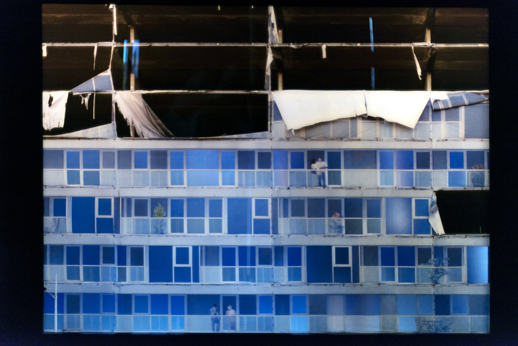10 Things in Tokyo: August Round-Up

For many, August is synonymous with war memorials and reflections on the losses throughout the world that have taken place at the hands of brute military power. As Japan marks the bombings of Hiroshima and Nagasaki and prepares to commemorate 70 years since the end of WWII, the intensity of the heat this month pushes itself that little bit more upon us. TAB collates here exhibitions to see through the peak of summer in pursuit of disagreeable pasts, divided presences, torrents of chaos and new orders.
Global Clashes
The reality of war is one which remains most elusive to those who have never encountered such conflict, but exhibitions such as “Stories of War Told Through Clothing” bring an intimate encounter with the experience of combat through garments worn by both the military and civilians during Japan’s times of war from the Edo era through WWII.
“War and Postwar – The Prism of the Times” at Izu Photo Museum casts its eye upon the events of the Asia-Pacific collisions through the work of leading photojournalists such as Ihei Kimura, Ken Domon, Yosuke Yamahata, and Shunkichi Kikuchi. Tracing the development of this form of reportage first harnessed by the state as a vehicle of propaganda, this exhibition lays out the issues of information and representation during time of conflict, from occupation, battle and the early Cold War, when individual photographers found themselves caught in national policy. (MuPon)
Problems of nationhood are also confronted in Sungdam Hong’s “East Asian Yasukunism” at Maruki Gallery for the Hiroshima Panels, which gazes unblinking upon Yasukuni Shrine, a site that to many has become a symbol of Japan’s wartime crimes. “Yasukunism” broadens its focus beyond Japan, however, to encompass the rise of aggressive nationalism through the East Asian region. Last month TABlog ran an article on an earlier exhibition of this work, which you can read here.
(Dis-)Joined Neighbors
The relations between East Asian nations, namely Japan and Korea, set the ground for an impressive collation of 12 artists as part of “Artist File 2015 Next Doors: Contemporary Art in Japan and Korea” at The National Art Center, Tokyo. The show includes an extraordinary construction by Wonho Lee, creating a “Homeless House” from cardboard bought from people living on the street, along with the visceral dissections of Aiko Tezuka’s sculptural embroidery and playful contraptions of light and movement from Junguk Yang. Reaching beyond mere geographical proximity, this show grasps upon links and ruptures in culture and aesthetics as critiqued through the work of these young artists.
Titling her exhibition with a quote from James Joyce’s “Dubliners,” a story of closed relations in middle-class Ireland, the Aesthetica Award-winning, Tokyo-based artist Suzanne Mooney presents “A Few Light Taps Upon the Pane, No One Turns, No Reply” at The Container. Meditating upon what it means to inhabit urban space, coexisting as we are with a myriad of other beings, Mooney physically divides the space of the gallery through the plane of her work, speaking of the boundaries drawn by lines of economy and urban alienation, rendered here through their very absence as seen in a large acrylic print of the half-built derelict high rises of the Sandyford Industrial Estate in south Dublin. These images dissolve distinctions between self and other as shadows and reflections of visitors merge with each other upon flat transparencies and opacities.
Time Past Time Present
Amongst this tide of reflections, we find ourselves also caught in the waves of time past and present, and it is amid these cyclical currents that the Ihei Kimura Award celebrates its 40th Anniversary with a special exhibition at the Kawasaki City Museum that measures out the timeline of this prestigious photography prize in what proves to be tour of contemporary Japanese photography. (MuPon)
The importance of the mechanical eye in capturing our multiple histories is also asserted in Mitsutoshi Hanaga’s “The Documentation Photographs of the Japanese Avant-garde Art and Performance: 1964–1973” at Aoyama Meguro gallery. Offering up a rich archive of legendary performances and exhibitions from the experimental era of the 1960s and 1970s, here audiences are provided with new visions of the iconic works of Hi-Red Center, Zero Jigen, Genpei Akasegawa and Tetsumi Kudo through 200 photographs, including previously unseen prints.
Disturbing Order
From structures of precise geometric order to ones which seek to disturb it, the artist duo Yoshihisa Tanaka and Ryuta Iida of Nerhol bring disruption to even the simplest of numbers in “01” at YKG Gallery. In photographs of sculptural distortions, we are reminded of the overpoweringly chaotic and contradictory flow of images that bombard us on the Internet, conjuring up many metaphors reflecting various aspects of contemporary society.
At the same time another two artists are questioning the predicates of modern rationalism and throwing the binary divisions of self and other, past and present to the wind, as we may witness in Akira Takayama and Meiro Koizumi’s joint exhibition “Demarcation” at Maison Hermès, under the curation of Fumihiko Sumitomo. With brimming frustration against the rigid structures of society, the works here make their way towards destabilizing the anchors upon which our systems and understanding rest and hint towards an impending turmoil.
Out of chaos there always springs new life, as seen in Takahiro Iwasaki’s “Dust and Moment” at Oyama City Kurumaya Museum of Art. These works remind us, there is always the possibility of building a new world from the fragments of another. Following on from his first solo show in Japan earlier this year under the title of “Many a Muckle Makes a Mickle” at Kurobe City Art Museum, he here continues to draw out new assemblages of meaning and matter from discarded and commonplace materials, taking up the dust of time and space to render a mirroring of parallel worlds.
Emma Ota
Emma Ota



